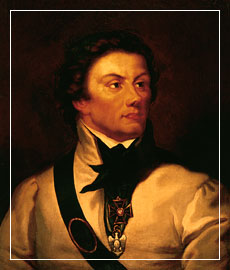The last place of residence of Kosciuszko became a topic of public interest when the Gassmann family, that had purchased the Zeltner family house in 1881, sold it to «Chocolat Villars AG» and when the company decided to turn the ground floor into a modern shop (1932).
This is when Polish ambassador in Bern, Jan Modzelewski, and cultural attaché, Dr. Alfons Bronarski, tried to save Kosciuszko's apartment, his last place of residence, and turn it into a museum. Support from Solothurn came from national councilor, Dr. Max Obrecht, as well as from the American Ambassador in Bern, Hughes R. Wilson.
In 1933, an honorary committee was appointed to develop the contents of the museum.
Thanks to fundraising efforts, including a concert in Solothurn by famous Polish pianist Ignacy Paderewski (1937), it was possible to recreate the room where Kosciuszko died in 1817 and restore its original look based on historical documents. To this end, the committee collected various paintings but had to satisfy itself with several copies as originals had been shipped from Rapperswil (home to the Polish Museum in Switzerland) to Poland in 1927. Nevertheless, numerous illustrations and prints were obtained from Polish museums and individuals. In Solothurn, the Gassmann family donated valuable Kosciuszko memorabilia including his personal belongings, that had most probably remained in his home when he passed away. The Italian descendants of Emilia Zeltner contributed to enrich the museum similarly.
The Polish state archives, the armory and the museum of art provided additional items and documents.
The official inauguration of the museum took place at Solothurn city hall on September 27, 1936, in presence of Polish Foreign Minister, Colonel Jozef Beck, and Swiss federal councilors Giuseppe Motta (five times Swiss Confederation President and League of Nations President in 1924-25) and Hermann Obrecht. The Polish, American and Swiss national anthems were played at the ceremony. The existing Kosciuszko Society was re-established to manage and maintain the museum and the Kosciuszko memorial in neighboring Zuchwil. Over time, the Society enriched the collection with new displays (gifted or purchased), attracted new members and raised the profile of the museum through concerts with Polish artists, lectures on Kosciuszko and celebrations of important jubilees.
On the 150th anniversary of Kosciuszko's death, the Society Secretary, Johann Arnold Wirth, wrote a play in his honor: «Tadeusz Kosciuszko, The Leader». As a result, the Society grew its membership to 735 by 1976, in Switzerland and abroad, counting many Poles and Americans – who also make up a good share of the visitors.
In 1978, the museum needed modernization but renovations were delayed for various reasons, including the time needed to raise CHF 90'000 for the works. Funds were donated by the Canton and the City of Solothurn, and numerous businesses and individuals, including many Poles. Meanwhile, the house was sold which initially put at risk the museum. The museum custodian also changed several times and the original renovation plans were improved and expanded - including the addition of a third room to the exhibit. Finally, between 1981-83, the museum was re-housed under the direction of Zygmunt Stankiewicz and Nicolo Vital. On 15 September 1984, the new museum and exhibition were inaugurated in a format that remains to this day.
In a special showcase is exhibited the pistol of Kosciuszko, that he carried during his stay in Paris. This original pistol has been bought on an auction in the year 2006.
The heart of the museum is an alcove, faithfully reproduced according to historical documents, and the bed on which Kosciuszko died on October 15, 1817.
